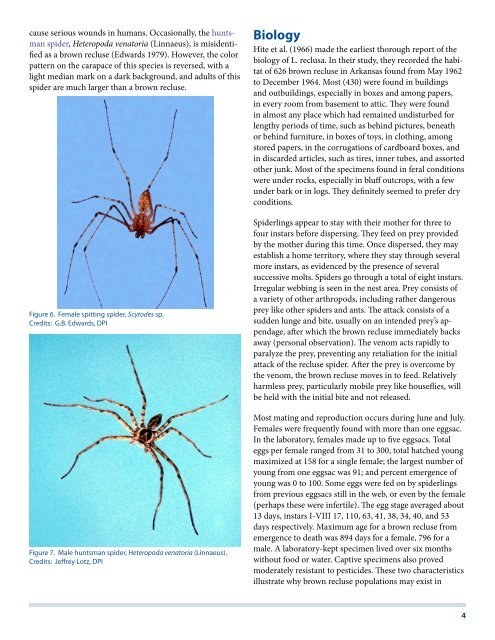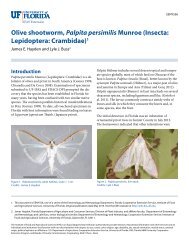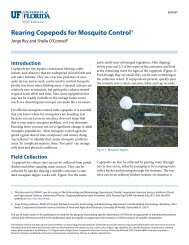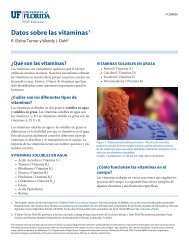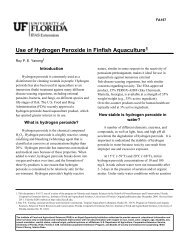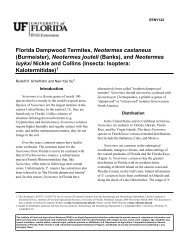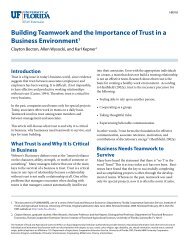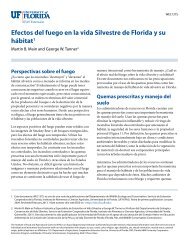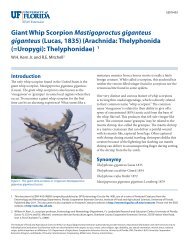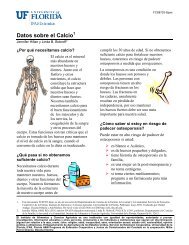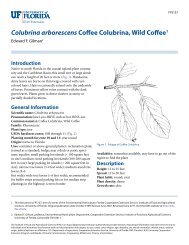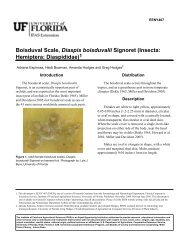Brown Recluse Spider, Loxosceles reclusa Gertsch and Mulaik ...
Brown Recluse Spider, Loxosceles reclusa Gertsch and Mulaik ...
Brown Recluse Spider, Loxosceles reclusa Gertsch and Mulaik ...
Create successful ePaper yourself
Turn your PDF publications into a flip-book with our unique Google optimized e-Paper software.
cause serious wounds in humans. Occasionally, the huntsman<br />
spider, Heteropoda venatoria (Linnaeus), is misidentified<br />
as a brown recluse (Edwards 1979). However, the color<br />
pattern on the carapace of this species is reversed, with a<br />
light median mark on a dark background, <strong>and</strong> adults of this<br />
spider are much larger than a brown recluse.<br />
Figure 6. Female spitting spider, Scytodes sp.<br />
Credits: G.B. Edwards, DPI<br />
Figure 7. Male huntsman spider, Heteropoda venatoria (Linnaeus).<br />
Credits: Jeffrey Lotz, DPI<br />
Biology<br />
Hite et al. (1966) made the earliest thorough report of the<br />
biology of L. <strong>reclusa</strong>. In their study, they recorded the habitat<br />
of 626 brown recluse in Arkansas found from May 1962<br />
to December 1964. Most (430) were found in buildings<br />
<strong>and</strong> outbuildings, especially in boxes <strong>and</strong> among papers,<br />
in every room from basement to attic. They were found<br />
in almost any place which had remained undisturbed for<br />
lengthy periods of time, such as behind pictures, beneath<br />
or behind furniture, in boxes of toys, in clothing, among<br />
stored papers, in the corrugations of cardboard boxes, <strong>and</strong><br />
in discarded articles, such as tires, inner tubes, <strong>and</strong> assorted<br />
other junk. Most of the specimens found in feral conditions<br />
were under rocks, especially in bluff outcrops, with a few<br />
under bark or in logs. They definitely seemed to prefer dry<br />
conditions.<br />
<strong>Spider</strong>lings appear to stay with their mother for three to<br />
four instars before dispersing. They feed on prey provided<br />
by the mother during this time. Once dispersed, they may<br />
establish a home territory, where they stay through several<br />
more instars, as evidenced by the presence of several<br />
successive molts. <strong>Spider</strong>s go through a total of eight instars.<br />
Irregular webbing is seen in the nest area. Prey consists of<br />
a variety of other arthropods, including rather dangerous<br />
prey like other spiders <strong>and</strong> ants. The attack consists of a<br />
sudden lunge <strong>and</strong> bite, usually on an intended prey’s appendage,<br />
after which the brown recluse immediately backs<br />
away (personal observation). The venom acts rapidly to<br />
paralyze the prey, preventing any retaliation for the initial<br />
attack of the recluse spider. After the prey is overcome by<br />
the venom, the brown recluse moves in to feed. Relatively<br />
harmless prey, particularly mobile prey like houseflies, will<br />
be held with the initial bite <strong>and</strong> not released.<br />
Most mating <strong>and</strong> reproduction occurs during June <strong>and</strong> July.<br />
Females were frequently found with more than one eggsac.<br />
In the laboratory, females made up to five eggsacs. Total<br />
eggs per female ranged from 31 to 300, total hatched young<br />
maximized at 158 for a single female; the largest number of<br />
young from one eggsac was 91; <strong>and</strong> percent emergence of<br />
young was 0 to 100. Some eggs were fed on by spiderlings<br />
from previous eggsacs still in the web, or even by the female<br />
(perhaps these were infertile). The egg stage averaged about<br />
13 days, instars I-VIII 17, 110, 63, 41, 38, 34, 40, <strong>and</strong> 53<br />
days respectively. Maximum age for a brown recluse from<br />
emergence to death was 894 days for a female, 796 for a<br />
male. A laboratory-kept specimen lived over six months<br />
without food or water. Captive specimens also proved<br />
moderately resistant to pesticides. These two characteristics<br />
illustrate why brown recluse populations may exist in<br />
4


